Molecular Dynamics Study of the Deformation Behavior and Strengthening Mechanisms of Cu/Graphene Composites under Nanoindentation
Abstract
:1. Introduction
2. Simulation Method
3. Results and Discussion
3.1. Effect of Graphene Position on Cu/gr Composites
3.1.1. Mechanical Performance
3.1.2. Plastic Deformation Behavior
3.1.3. Dislocation Density
3.2. Effect of Graphene Layers on Cu/gr Composites
3.2.1. Mechanical Performance
3.2.2. Plastic Deformation Behavior
3.2.3. Dislocation Density
4. Conclusions
- (1)
- The maximum pressure and hardness of Cu/gr composites during nanoindentation significantly decreased as the distance from graphene to the indentation surface increased. The incorporation of graphene had a more significant strengthening effect.
- (2)
- During the indentation process, a denser network of dislocations was produced below the Cu/Gr interface than in pure Cu to effectively impede the movement of the dislocations, which is the main reason why the incorporation of graphene was able to strengthen the Cu/Gr composites.
- (3)
- The maximum pressure and hardness of Cu/gr composites significantly increased with the number of graphene layers during nanoindentation. In addition, the high-shear-strain atomic region also increased with the graphene layers.
- (4)
- During the indentation process, the loading was transferred directly to the graphene reinforcement through the Cu/gr interface, which made the stress in graphene significantly larger than that in the Cu matrix, and this fully exploited the advantages of the high strength of graphene.
Author Contributions
Funding
Data Availability Statement
Conflicts of Interest
References
- Cui, L.; Luo, R.; Wang, L.; Luo, H.; Deng, C. Novel copper-impregnated carbon strip for sliding contact materials. J. Alloys Compd. 2018, 735, 1846–1853. [Google Scholar] [CrossRef]
- Mazloum, A.; Kováčik, J.; Zagrai, A.; Sevostianov, I. Copper-graphite composite: Shear modulus, electrical resistivity, and cross-property connections. Int. J. Eng. Sci. 2020, 149, 103232. [Google Scholar] [CrossRef]
- Lee, C.; Wei, X.; Kysar, J.W.; Hone, J. Measurement of the elastic properties and intrinsic strength of monolayer graphene. science 2008, 321, 385–388. [Google Scholar] [CrossRef] [PubMed]
- Tjong, S.C. Recent progress in the development and properties of novel metal matrix nanocomposites reinforced with carbon nanotubes and graphene nanosheets. Mater. Sci.Eng. R Rep. 2013, 74, 281–350. [Google Scholar] [CrossRef]
- Wei, W.; Song, Y.; Yang, Z.; Gao, G.; Xu, P.; Lu, M.; Tu, C.; Chen, M.; Wu, G. Investigation of the impacts of thermal shock on carbon composite materials. Materials 2019, 12, 435. [Google Scholar] [CrossRef] [PubMed]
- Kim, Y.; Lee, J.; Yeom, M.S.; Shin, J.W.; Kim, H.; Cui, Y.; Kysar, J.W.; Hone, J.; Jung, Y.; Jeon, S. Strengthening effect of single-atomic-layer graphene in metal–graphene nanolayered composites. Nat. Commun. 2013, 4, 2114. [Google Scholar] [CrossRef] [PubMed]
- Wang, J.; Li, Z.; Fan, G.; Pan, H.; Chen, Z.; Zhang, D. Reinforcement with graphene nanosheets in aluminum matrix composites. Scr. Mater. 2012, 66, 594–597. [Google Scholar] [CrossRef]
- Gao, X.; Yue, H.; Guo, E.; Zhang, H.; Lin, X.; Yao, L.; Wang, B. Mechanical properties and thermal conductivity of graphene reinforced copper matrix composites. Powder Technol. 2016, 301, 601–607. [Google Scholar] [CrossRef]
- Rafiee, M.A.; Rafiee, J.; Wang, Z.; Song, H.; Yu, Z.-Z.; Koratkar, N. Enhanced mechanical properties of nanocomposites at low graphene content. ACS Nano 2009, 3, 3884–3890. [Google Scholar] [CrossRef]
- Kazakov, A.M.; Korznikova, G.F.; Tuvalev, I.I.; Izosimov, A.A.; Korznikova, E.A. The Effect of Copper–Graphene Composite Architecture on Thermal Transport Efficiency. Materials 2023, 16, 7199. [Google Scholar] [CrossRef]
- Guo, J.; Wang, B.; Yang, Z. Molecular dynamics simulations on the mechanical properties of graphene/Cu composites. Acta Mater. Compos. Sin. 2014, 31, 152–157. [Google Scholar]
- Xu, R.; Zhou, M.; Wang, X.; Matharage, S.Y.; Yan, J.D.; Connolly, A.; Luo, Y.; Ding, Y.; Wang, Z. A molecular dynamics simulation study on the role of graphene in enhancing the arc erosion resistance of Cu metal matrix. Comput. Mater. Sci. 2022, 212, 111549. [Google Scholar] [CrossRef]
- Weng, S.; Ning, H.; Fu, T.; Hu, N.; Zhao, Y.; Huang, C.; Peng, X. Molecular dynamics study of strengthening mechanism of nanolaminated graphene/Cu composites under compression. Sci. Rep. 2018, 8, 3089. [Google Scholar] [CrossRef] [PubMed]
- Wang, X.; Su, Y.; Han, S.; Crimp, M.A.; Wang, Y.; Wang, Y. Elastic recovery induced strengthening effect in copper/multilayer-graphene interface regions revealed by instrumental nanoindentation. Compos. Part B Eng. 2021, 216, 108832. [Google Scholar] [CrossRef]
- Peng, W.; Sun, K.; Abdullah, R.; Zhang, M.; Chen, J.; Shi, J. Strengthening mechanisms of graphene coatings on Cu film under nanoindentation: A molecular dynamics simulation. Appl. Surf. Sci. 2019, 487, 22–31. [Google Scholar] [CrossRef]
- Peng, W.; Sun, K.; Zhang, M.; Shi, J.; Chen, J. Effects of graphene coating on the plastic deformation of single crystal copper nano-cuboid under different nanoindentation modes. Mater. Chem. Phys. 2019, 225, 1–7. [Google Scholar] [CrossRef]
- Stuart, S.J.; Tutein, A.B.; Harrison, J.A. A reactive potential for hydrocarbons with intermolecular interactions. J. Chem. Phys. 2000, 112, 6472–6486. [Google Scholar] [CrossRef]
- Foiles, S.; Baskes, M.; Daw, M.S. Embedded-atom-method functions for the fcc metals Cu, Ag, Au, Ni, Pd, Pt, and their alloys. Phys. Rev. B 1986, 33, 7983. [Google Scholar] [CrossRef]
- Shuang, F.; Aifantis, K.E. Dislocation-graphene interactions in Cu/graphene composites and the effect of boundary conditions: A molecular dynamics study. Carbon 2021, 172, 50–70. [Google Scholar] [CrossRef]
- Zhang, S.; Huang, P.; Wang, F. Graphene-boundary strengthening mechanism in Cu/graphene nanocomposites: A molecular dynamics simulation. Mater. Des. 2020, 190, 108555. [Google Scholar] [CrossRef]
- Stukowski, A. Visualization and analysis of atomistic simulation data with OVITO–the Open Visualization Tool. Model. Simul. Mater. Sci. Eng. 2009, 18, 015012. [Google Scholar] [CrossRef]
- Pham, V.-T.; Fang, T.-H. Pile-up and heat effect on the mechanical response of SiGe on Si (0 0 1) substrate during nanoscratching and nanoindentation using molecular dynamics. Comput. Mater. Sci. 2020, 174, 109465. [Google Scholar] [CrossRef]
- Wang, T.H.; Fang, T.-H.; Lin, Y.-C. A numerical study of factors affecting the characterization of nanoindentation on silicon. Mater. Sci.Eng. A 2007, 447, 244–253. [Google Scholar] [CrossRef]
- Fazeli, S.; Sadrnezhaad, S.K. Molecular dynamics simulation of plastic deformation and interfacial delamination of NiTi/Ag bilayer by cyclic-nanoindentation: Effects of crystallographic orientation of substrate. Comput. Mater. Sci. 2019, 168, 229–245. [Google Scholar] [CrossRef]
- Zhu, J.; Liu, X.; Zhou, X.; Yang, Q. Strengthening effect of graphene-edge dislocation interaction in graphene reinforced copper matrix composites. Comput. Mater. Sci. 2021, 188, 110179. [Google Scholar] [CrossRef]
- Hua, D.; Xia, Q.; Wang, W.; Zhou, Q.; Li, S.; Qian, D.; Shi, J.; Wang, H. Atomistic insights into the deformation mechanism of a CoCrNi medium entropy alloy under nanoindentation. Int. J. Plast. 2021, 142, 102997. [Google Scholar] [CrossRef]
- Othon, M.; Morra, M. EBSD characterization of residual plastic strain across alloy 182 weld joints. Microsc. Microanal. 2005, 11, 522–523. [Google Scholar] [CrossRef]
- Saithala, J.; Mahajanam, S.; Ubhi, H.; Atkinson, J. Environmental assisted cracking behavior of sigmatized super duplex stainless steel in oilfield production brine. Corrosion 2013, 69, 276–285. [Google Scholar] [CrossRef]
- Durst, K.; Backes, B.; Göken, M. Indentation size effect in metallic materials: Correcting for the size of the plastic zone. Scr. Mater. 2005, 52, 1093–1097. [Google Scholar] [CrossRef]
- Gao, Y.; Ruestes, C.J.; Tramontina, D.R.; Urbassek, H.M. Comparative simulation study of the structure of the plastic zone produced by nanoindentation. J. Mech. Phys. Solids 2015, 75, 58–75. [Google Scholar] [CrossRef]
- Yaghoobi, M.; Voyiadjis, G.Z. Atomistic simulation of size effects in single-crystalline metals of confined volumes during nanoindentation. Comput. Mater. Sci. 2016, 111, 64–73. [Google Scholar] [CrossRef]
- Qi, Y.; Xu, H.; He, T.; Feng, M. Effect of crystallographic orientation on mechanical properties of single-crystal CoCrFeMnNi high-entropy alloy. Mater. Sci.Eng. A 2021, 814, 141196. [Google Scholar] [CrossRef]
- Yuan, F.; Cheng, W.; Zhang, S.; Liu, X.; Wu, X. Atomistic simulations of tensile deformation in a CrCoNi medium-entropy alloy with heterogeneous grain structures. Materialia 2020, 9, 100565. [Google Scholar] [CrossRef]
- Voyiadjis, G.Z.; Yaghoobi, M. Large scale atomistic simulation of size effects during nanoindentation: Dislocation length and hardness. Mater. Sci.Eng. A 2015, 634, 20–31. [Google Scholar] [CrossRef]
- Khobragade, N.; Maity, T.; Świderska-Środa, A.; Stanislaw, G.; Łojkowski, W.; Babu, P.N.; Pal, S.; Roy, D. Dislocation entangled mechanisms in cu-graphene nanocomposite fabricated by high-pressure sintering. Mater. Charact. 2023, 195, 112524. [Google Scholar] [CrossRef]
- Khobragade, N.; Sikdar, K.; Kumar, B.; Bera, S.; Roy, D. Mechanical and electrical properties of copper-graphene nanocomposite fabricated by high pressure torsion. J. Alloys Compd. 2019, 776, 123–132. [Google Scholar] [CrossRef]
- Li, Z.; Cui, Y.; Yan, W.; Zhang, D.; Fang, Y.; Chen, Y.; Yu, Q.; Wang, G.; Ouyang, H.; Fan, C. Enhanced strengthening and hardening via self-stabilized dislocation network in additively manufactured metals. Mater. Today 2021, 50, 79–88. [Google Scholar] [CrossRef]


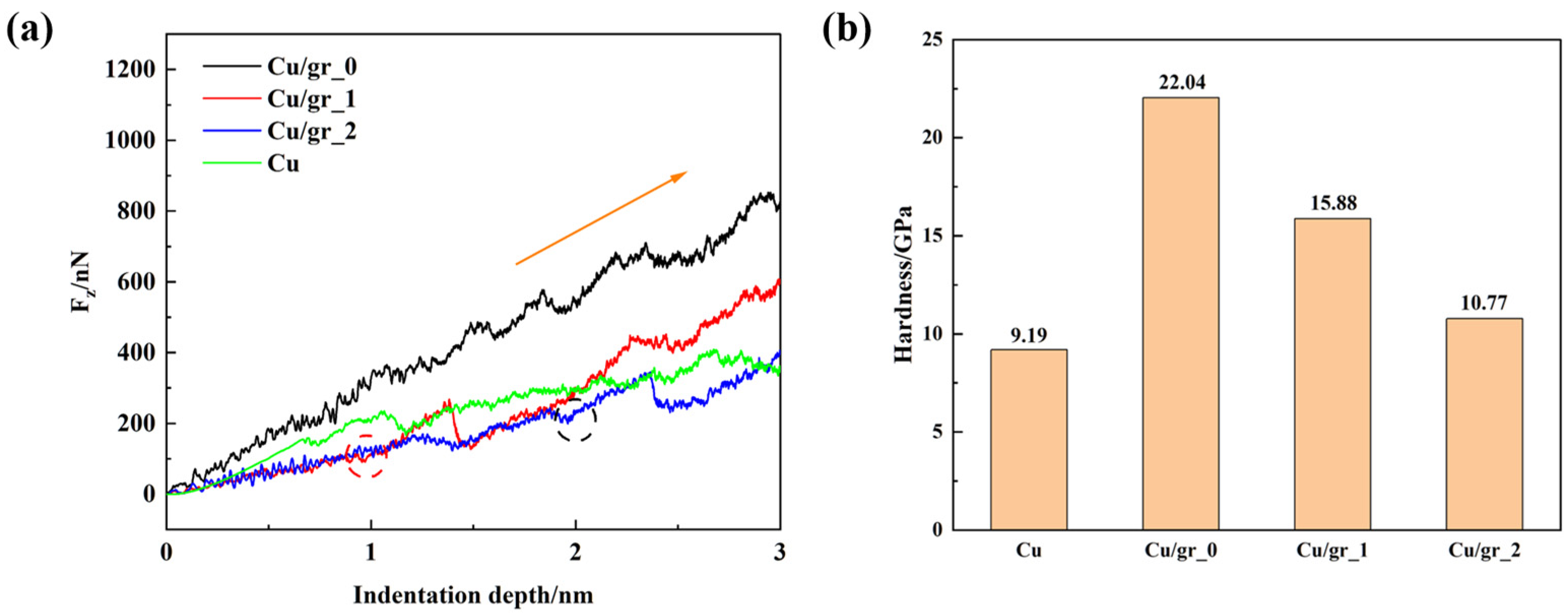
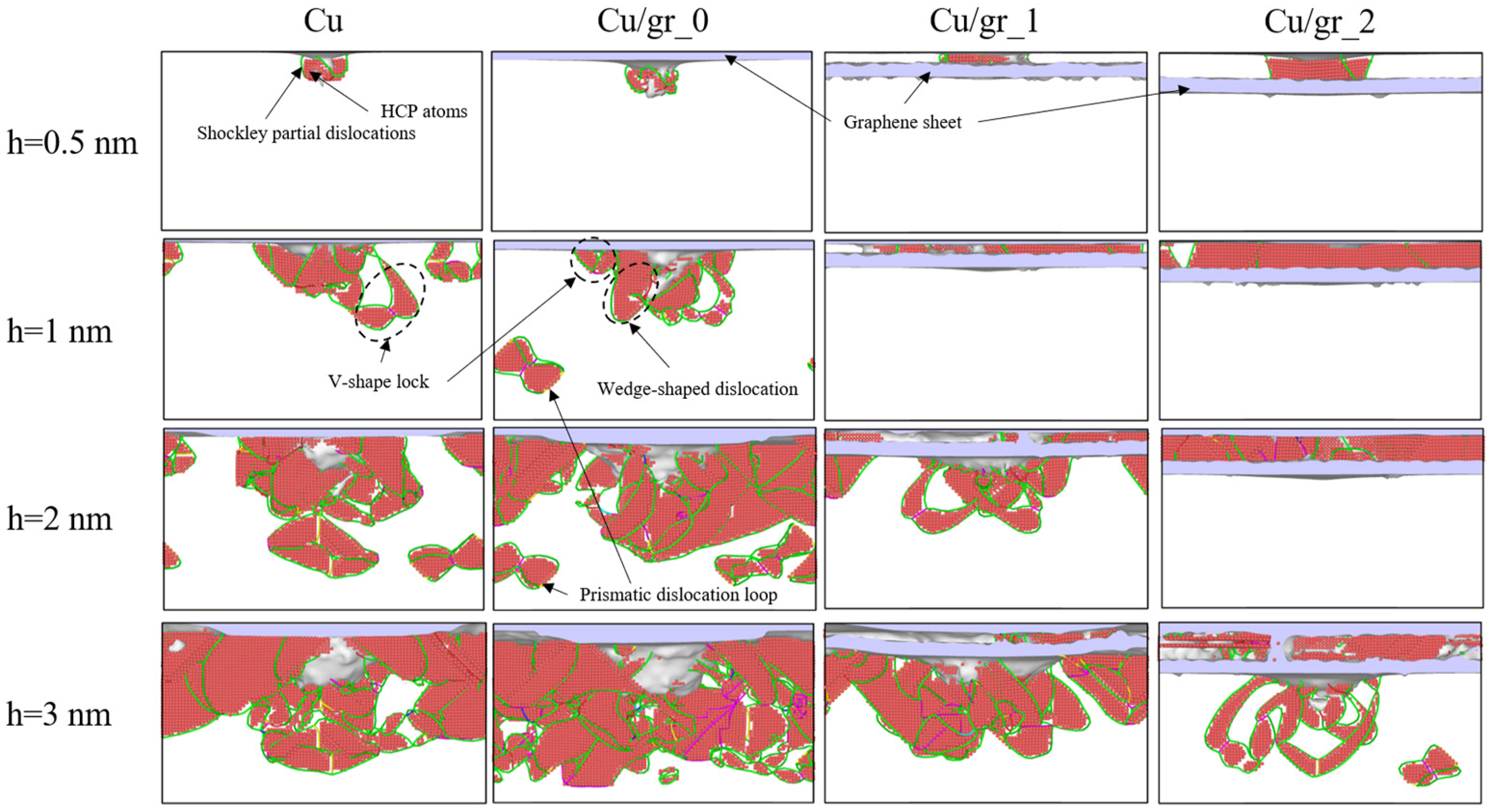
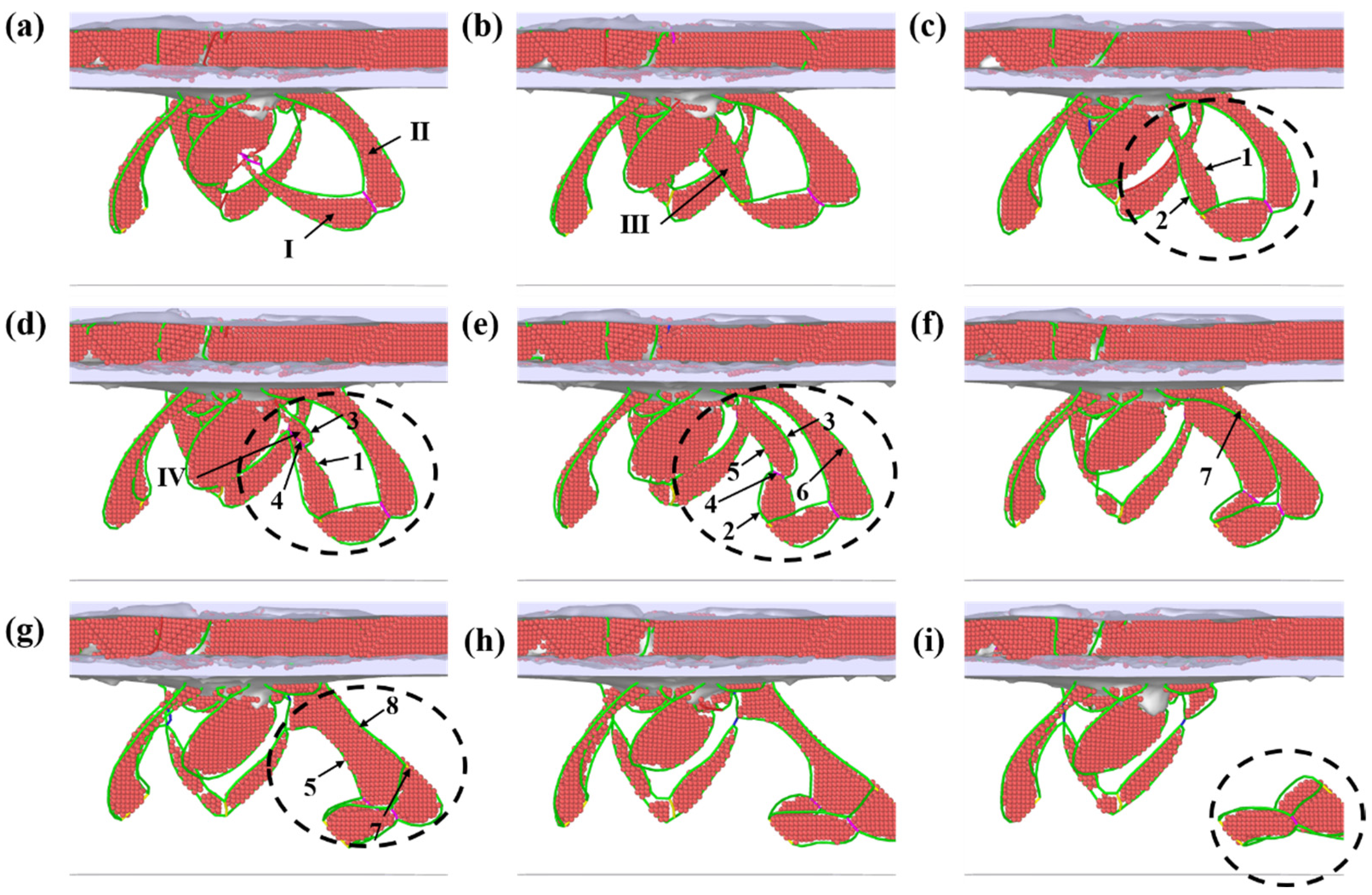

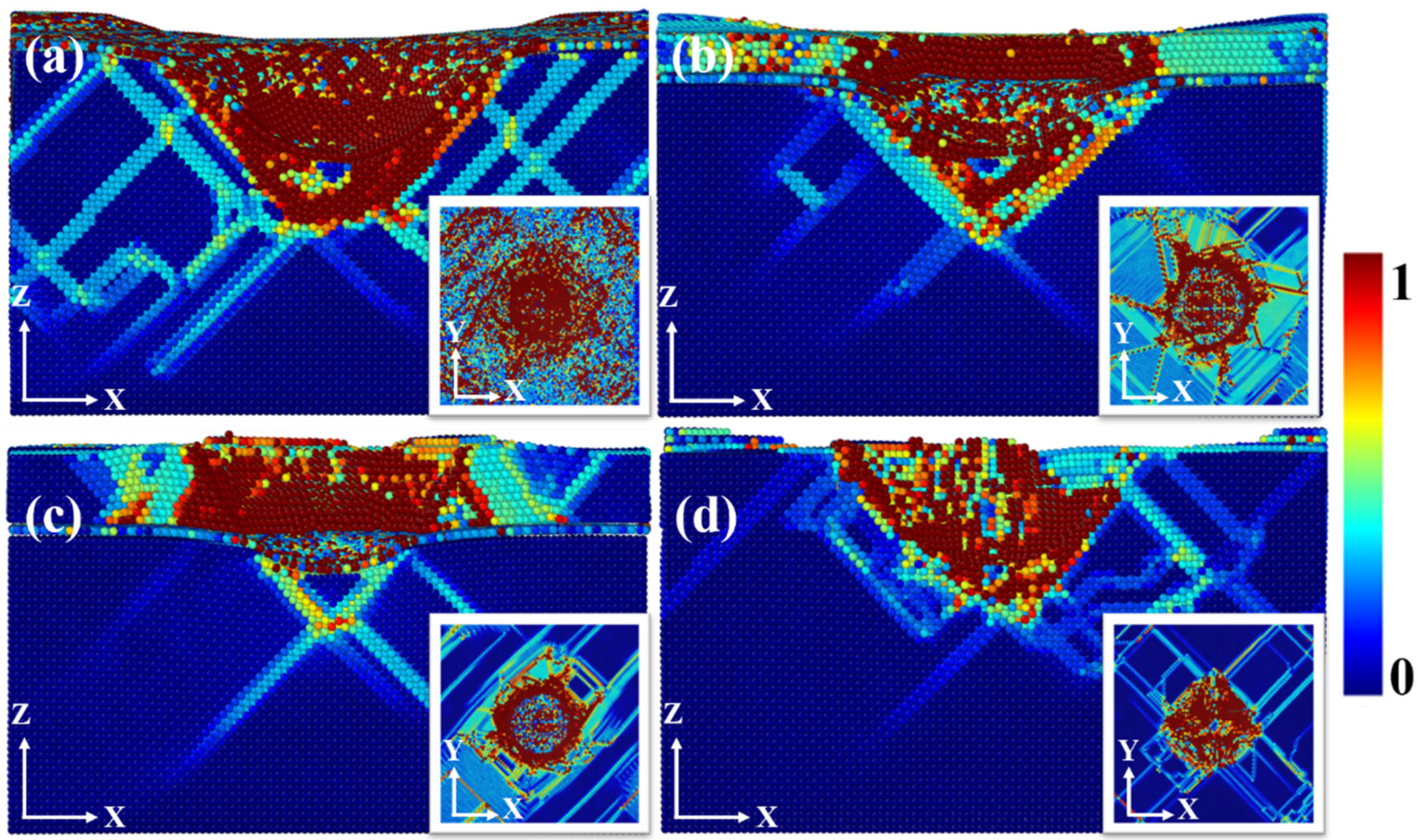
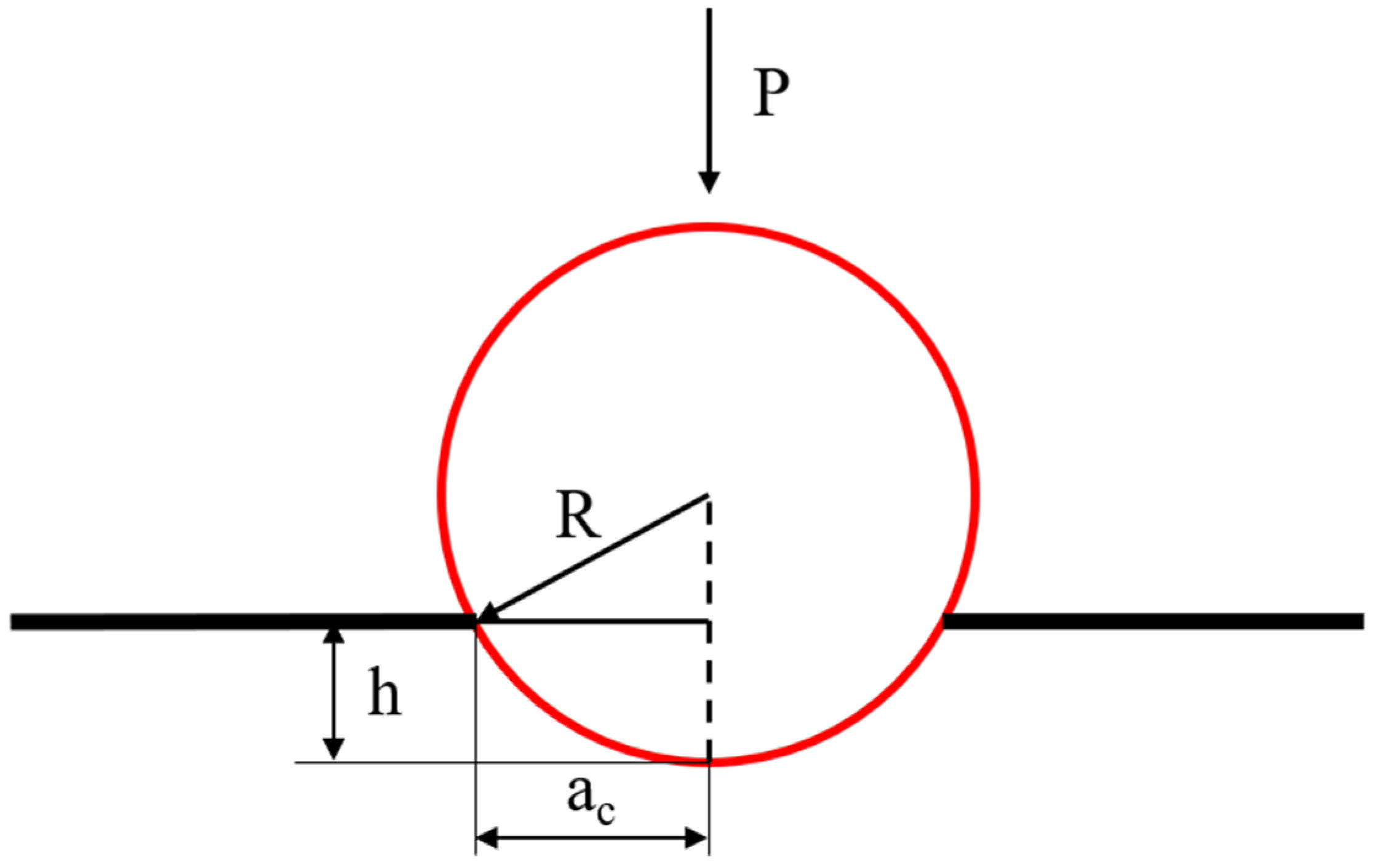
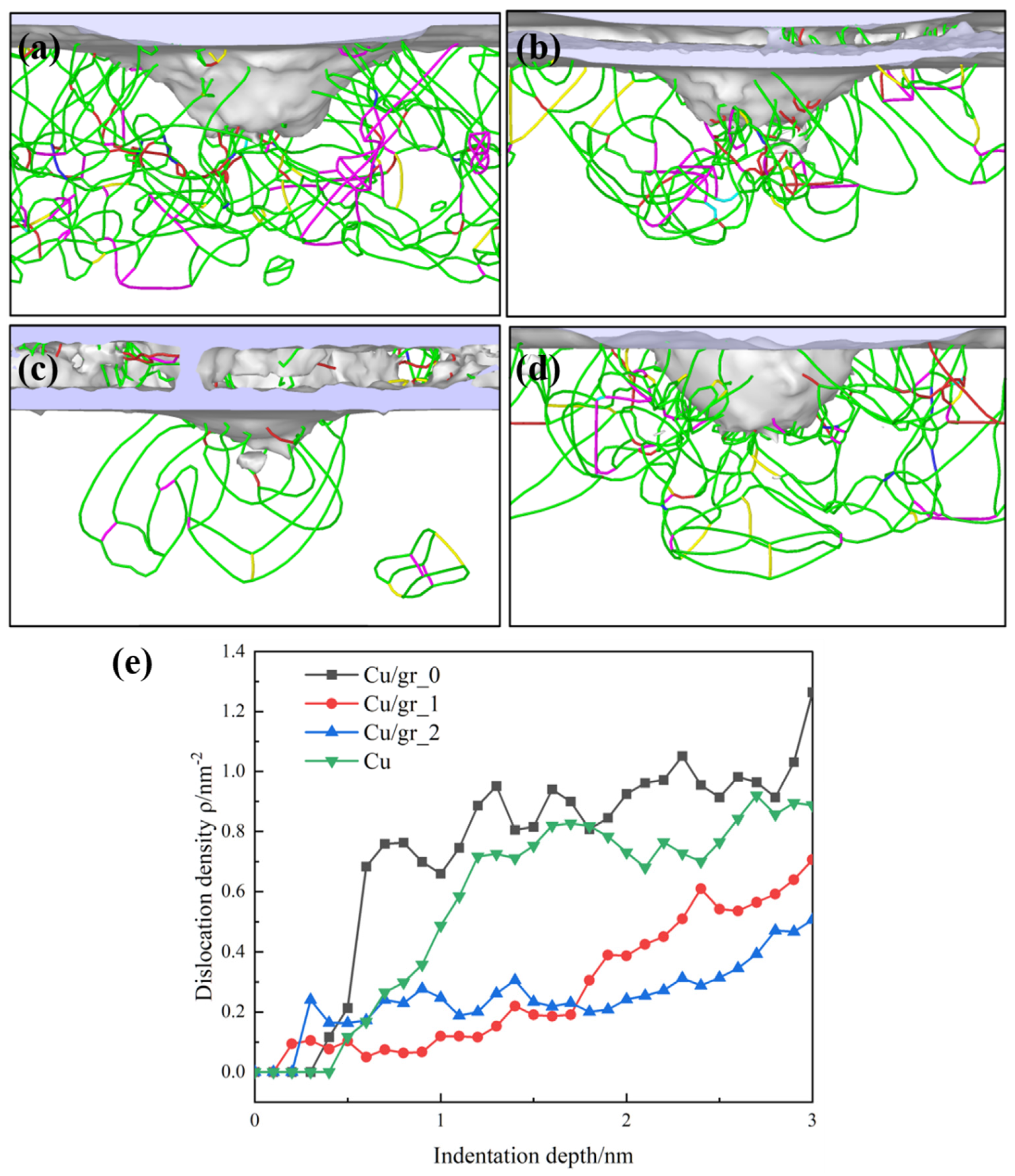
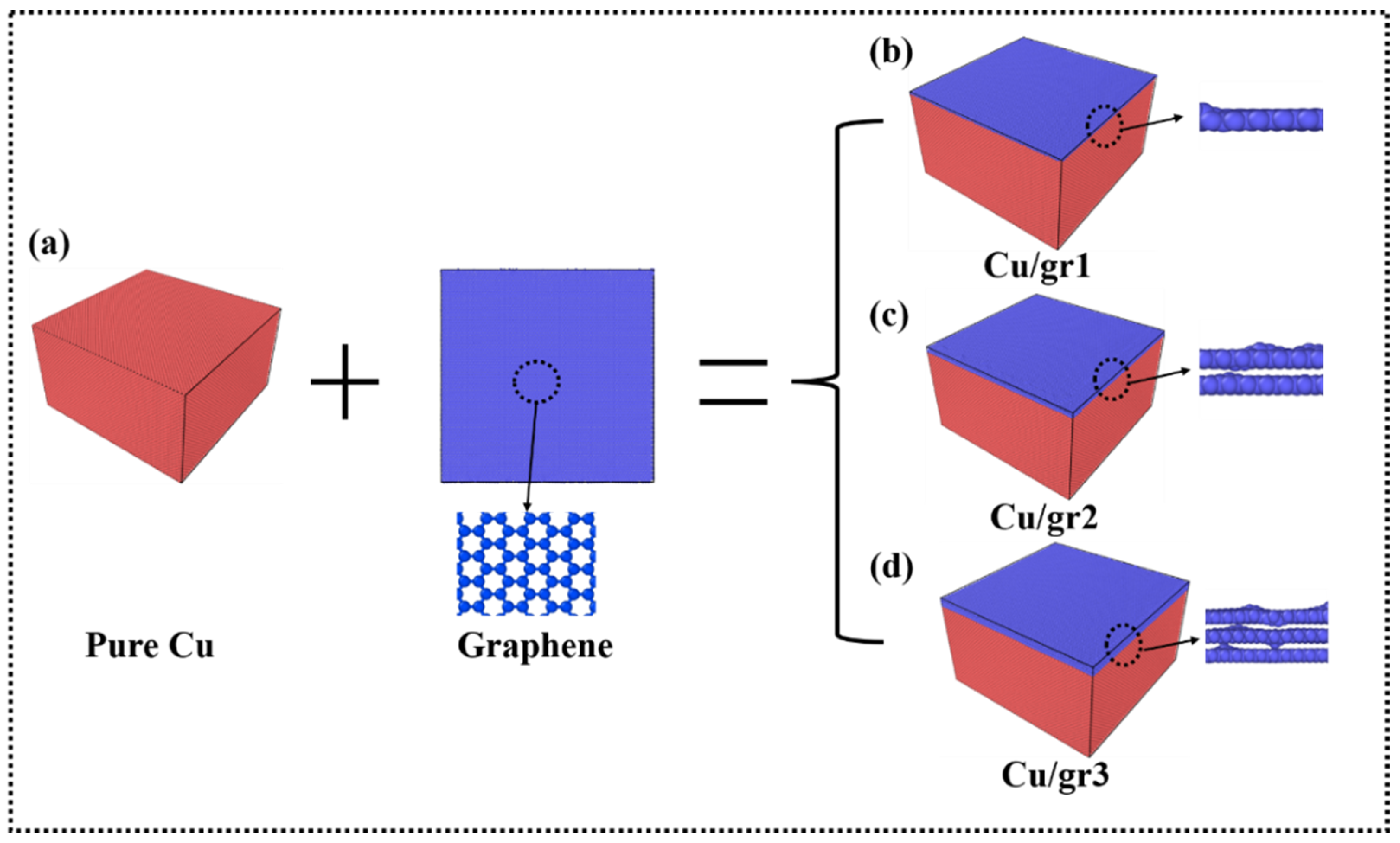
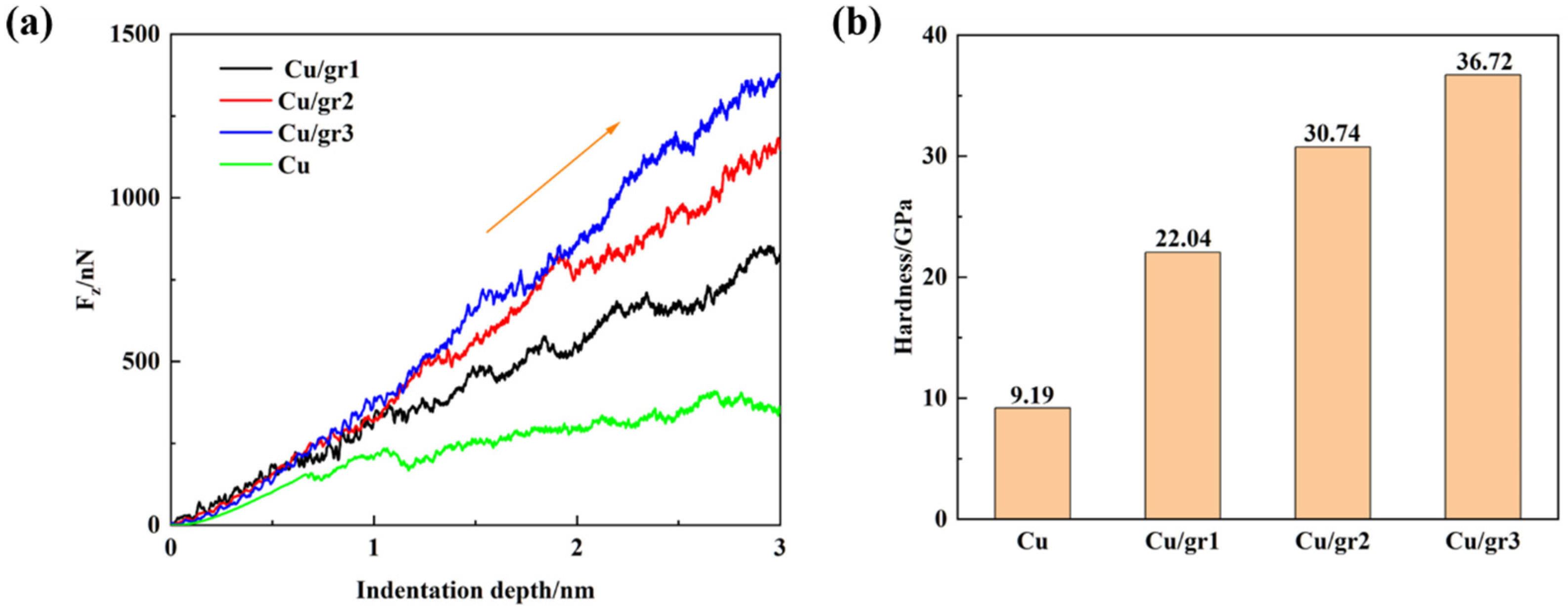

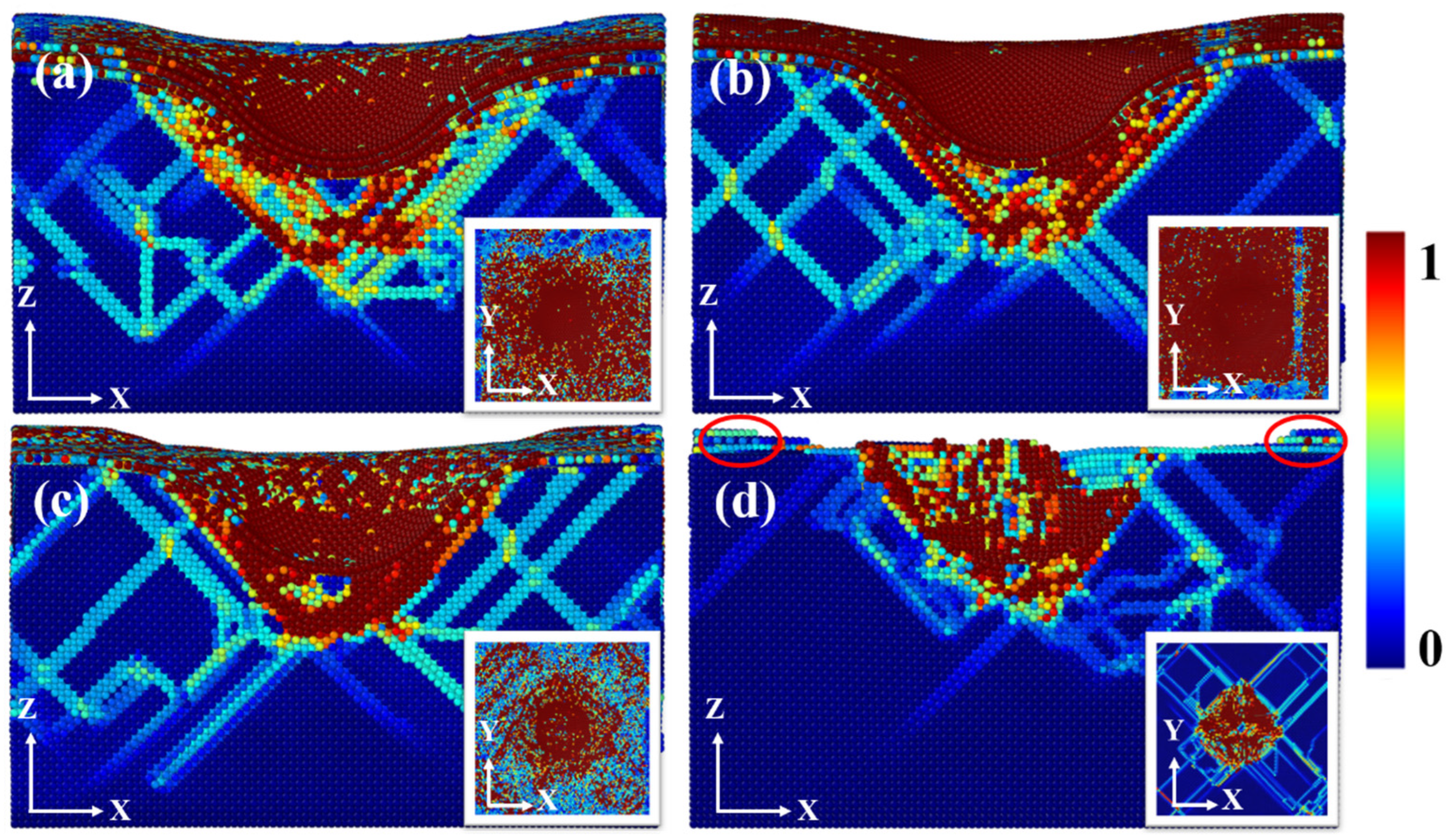

Disclaimer/Publisher’s Note: The statements, opinions and data contained in all publications are solely those of the individual author(s) and contributor(s) and not of MDPI and/or the editor(s). MDPI and/or the editor(s) disclaim responsibility for any injury to people or property resulting from any ideas, methods, instructions or products referred to in the content. |
© 2024 by the authors. Licensee MDPI, Basel, Switzerland. This article is an open access article distributed under the terms and conditions of the Creative Commons Attribution (CC BY) license (https://creativecommons.org/licenses/by/4.0/).
Share and Cite
Ren, G.; Zhou, C.; Hu, Y.; Wang, L.; Fang, J.; Li, Y.; Wang, Y.; Liu, J.; Zhang, M.; Tong, Y. Molecular Dynamics Study of the Deformation Behavior and Strengthening Mechanisms of Cu/Graphene Composites under Nanoindentation. Crystals 2024, 14, 525. https://doi.org/10.3390/cryst14060525
Ren G, Zhou C, Hu Y, Wang L, Fang J, Li Y, Wang Y, Liu J, Zhang M, Tong Y. Molecular Dynamics Study of the Deformation Behavior and Strengthening Mechanisms of Cu/Graphene Composites under Nanoindentation. Crystals. 2024; 14(6):525. https://doi.org/10.3390/cryst14060525
Chicago/Turabian StyleRen, Guangan, Cong Zhou, Yongle Hu, Li Wang, Jingzhong Fang, Yejun Li, Yi Wang, Jian Liu, Mingjun Zhang, and Yonggang Tong. 2024. "Molecular Dynamics Study of the Deformation Behavior and Strengthening Mechanisms of Cu/Graphene Composites under Nanoindentation" Crystals 14, no. 6: 525. https://doi.org/10.3390/cryst14060525





